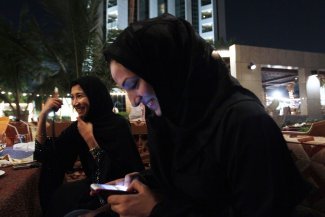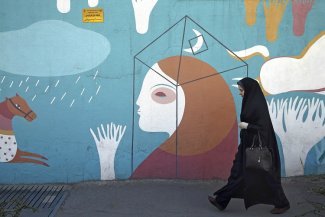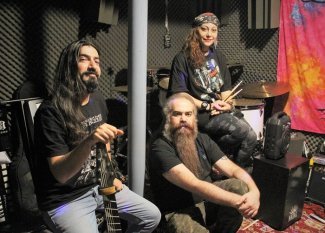Solidarity demonstrations are being held in major cities around the world, from Sydney to Los Angeles. “Die, die dictator!”, “Woman, life and freedom!” chant hundreds of women and men at a rally in the Turkish port of Kadiköy on the Asian shore of the Bosphorus in early October.
Cutting one’s hair is a mourning ritual for the death of a loved one, a tradition already recorded a thousand years ago in the epic poem Shahnameh (Book of Kings), written by Persian poet Ferdowsi. This tradition is still widely observed in Iranian Kurdistan, and in recent weeks it has become a form of protest used by Iranian women to express their pain and their anger at the abuses they suffer.
“Woman, life and freedom!” shouted Swedish-Iraqi MEP Abir al Sahlani after cutting her hair in front of the cameras on 4 October. It is a gesture that has been emulated on social media by dozens of celebrities such as Penélope Cruz and Juliette Binoche. Meanwhile, Angelina Jolie has expressed her respect and admiration for the Iranian women leading the protests calling for an end to the compulsory hijab and the Islamic regime.
The current protests were sparked by the death, in mid-September, of a 22-year-old Kurdish woman Mahsa Amini, after she was beaten by the Basij, or morality police, for exposing part of her hair under her headscarf. At least 201 people, including several minors, have since been killed in the violent crackdown on the protests.
Solidarity demonstrations are being held in major cities around the world, from Sydney to Los Angeles, especially those where a large part of a diaspora of more than four million people (out of a population of 86 million) has fled the repression of the Tehran regime over the last four decades.
According to Iranian migration data, around 140,000 Iranians are living in exile in neighbouring Turkey. Protests are regularly held in front of Iranian diplomatic missions or in central parts of Istanbul, Ankara and Izmir.
“Die, die dictator!”, “Woman, life and freedom!” chant hundreds of women and men at a rally in the port of Kadiköy on the Asian shore of the Bosphorus in early October. The women burn their black hijabs and throw them into the evening sky. They carry white flowers, pictures of Mahsa Amini and banners calling for an end to the regime of the ayatollahs. Some chop off their hair and hold it up in their fists. The crowd shouts, cheers and sings the protest anthem, Baraye.
Many of the protesters are Iranian, but there are also Kurdish and Turkish feminists and left-wing activists. Turkish riot police outnumber the protesters, although the Turkish government has not commented on the protests.
“My friends in Iran are demonstrating. I trust everything is going to go well there, the revolution is going to go well. They are going to change the regime in Iran and move towards a democracy,” Khatereh, a protester who left Iran a year ago, tells Equal Times.
Yes, she is aware that her friends may die in the protests: “That’s the price of freedom, and it’s a price we’re willing to pay.”
Other teenagers have already died, such as Nika Shakarami, Nima Shafighdoust and Sarina Esmailzadeh who – along with Amini – are becoming symbols of a generation that has grown up with social media networks such as TikTok, Twitter and Telegram, has access to the international press and aspires to what it calls “a normal life”, without restrictions. They are just young girls, but they are bold enough to film themselves in videos jumping on pictures of Ayatollah Ruhollah Khomeini (1902-1989) and his current successor, ailing 83-year-old Ayatollah Ali Khamenei, both supreme religious leaders.
Equality for women and beyond
The mobilisations in Iran are leaderless. “This is both good and bad. Bad because it makes organising more complicated, and good because the regime can’t stop the movement by decapitating its leaders,” as was the case in 2009, says Kaveh Nematipour, a 42-year-old Green Movement activist who has been living in Istanbul for ten years. “The mobilisations are spontaneous. People go out in the evenings and if they see a small group, they join in and start chanting. People have had enough. Everyone wants a change: the Kurds, the poor, the liberals,” she tells Equal Times.
“I am a girl from Iran who wants a liberal, secular and democratic government so that I can live a normal life in our country,” explains another protester of around 20, in Istanbul, who chooses not to give her name for security reasons. She adds: “We are protesting against the harassment we suffer as women in the streets, in schools, in universities, in the family. We are forced to wear a hijab when we go out, and if you don’t follow Islamic law, you can be punished or imprisoned.”
The young woman describes some of the constraints on Iranian women’s lives: they cannot sing or dance in public, participate in many types of sports, or travel without their husbands’ permission. There is gender segregation in education.
Sharia law prohibits women from initiating a divorce or having custody of their children; they are considered to be worth half a man when it comes to legal testimony, inheritance and death benefits, and the legal age for girls to marry is 13, or nine with the father’s permission. Men can have up to four permanent wives, and an unlimited number of temporary wives. Husbands can rape their wives or daughters – and bosses their female employees – with virtual impunity. The law does not prohibit honour crimes or genital mutilation. Women are barred from certain professions. And, up until 2019, women were not allowed to attend football matches. It took the death of a young woman, who set herself on fire, for the authorities to relent, under international pressure.
This draconian framework (set by the law, and sometimes in spite of it) clashes with a reality in which there are more women university graduates than men. The employment rate among women is, nonetheless, only 14 per cent, one of the lowest in the world.
The economic situation has worsened with the pandemic. And restrictions on women have been tightened since Ebrahim Raisi, linked to a 1988 prison massacre in Iran in which 5,000 people were killed, became president in 2021.
The young woman protesting in Istanbul lists a number of other grievances: “The daughters and granddaughters of our politicians, who live in the US or the UK, are free. They pose half naked on social media. Yet we are not free, we have no rights, we have no opportunities, and we are getting poorer by the day”.
Some observers are already talking of Iran’s first women-led revolution. But, as Azadeh Pourzand, human rights advocacy officer at Impact Iran, points out, Iranian women have been involved in all the uprisings over the last century.
“Women have always been among the vanguard during most protests in contemporary Iran, be it at the time of the 1979 Islamic Revolution, the Green Movement (2009), or the nationwide protests of December 2017, January 2018 and November 2019,” Pourzand, who is also executive director of the Siamak Pourzand Foundation for freedom of expression, set up in honour of her father, a journalist and prisoner of conscience who committed suicide in 2011 while under house arrest, tells Equal Times.
The women’s rights movement “is also one of the oldest and strongest grassroots movements, going back a hundred years, despite the Islamic Republic’s violent repression over the past four decades”, she adds. The history of this movement goes back even further than the Constitutional Revolution (1905-11), when women began to demand access to education.
Following the 1921 coup d’état led by Reza Shah Pahlavi (monarch from 1925-41), a number of radical secular reforms were introduced, including the emancipation of women and the removal of clerical privileges. In a bid to modernise the country, Pahlavi ordered his soldiers to strip women of their veils, even at gunpoint, and men of their turbans. Religious students who protested were gunned down in the streets. Despite the dynasty’s heavy-handedness and corruption, its liberal reforms paved the way for the Family Protection Act (1966), and women won the right to vote in 1965. Imposed secularism, however, fuelled a radical religious and anti-Western backlash, and when Khomeini took power women’s rights were abolished and the hijab was made mandatory and remains so to this day.
Pourzand points to what distinguishes the current revolution from previous ones. “It has two key features: the central role of women’s rights and the overlap with the fundamental demands and grievances of the rest of the nation.”
“Although the protests were sparked by the death of Mahsa Amini, and opposition to the mandatory hijab and the morality police, the demands have now grown into calls for a change of regime,” she continues.
Another key element is “...the critical role of Generation Z, without whose courage and incredible sense of grassroots mobilisation we would not be where we are today in terms of the progress made in the struggle. These protests are a monumental event in the Iran of today and I believe they mark a before and after in the country,” says Pourzand.
The average age of the protesters is just over 18. “This young generation has said, ‘We’re screwed’, and they’re taking the lead because they don’t see a future. One salary per household is not enough and they can’t leave the country, like we did, or lead a normal life. They have nothing to lose and have said: Enough of this,’” says Kaveh Nematipour. “In 2009, we were soft compared to them. In my day, we could go to a European university but, now, you have to be rich to do that. It costs €8,000 for a European visa.”
The young people’s desire for freedom is resonating with an impoverished population, unable to make a living, rampant inflation of 80 per cent and corrosive corruption that cannot be hidden from view on social media.
Analysts and protesters agree that the violence is not likely to cease in the coming months and more reprisals and killings are expected, as the regime has made it clear that the hijab is non-negotiable. If the veil falls, the ayatollahs fall.













